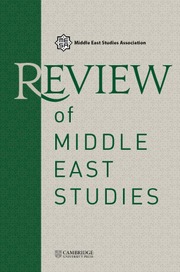No CrossRef data available.
Article contents
One Ideology, Two Paths: Gender, Education, and Emigration among the Lebanese Shīʿa of Jabal ʿĀmil and the Biqāʾ
Published online by Cambridge University Press: 09 March 2016
Extract
The demarcation of borders in the Middle East undermined the position of the Shia community in Lebanon. The French and the British agreement on the border between Lebanon and mandatory Palestine in the early 1920s reduced the size of mountainous region of Jabal ʿAmil. Among the Shia, the Jabal ʿAmil was historically known as the area extending from the Awali River in the north down to Acre, Tarshiha, and Safad in the south, and from the Mediterranean in the west to the Hula Lake and up to the Taym, south of the Biqaʾ Valley in the east. In 1924, an area of about 250,000 dunums (an Ottoman unit of land measurement), including several villages and the Hula Lake, was detached from the Jabal ʿAmil and added to mandatory Palestine. This act severely disrupted the socioeconomic life of the region, particularly around Marjaʾyun. Shia anger over the loss of land was reinforced by the fact that in modern Lebanon the Jabal ʿAmil became known simply as “the South,” which the Shia took as an insult to their historical heritage.
- Type
- Special Section
- Information
- Copyright
- Copyright © Middle East Studies Association of North America, Inc. 2013
References
End Notes
1 Fahs, Hani, al-Shiaʿ wa al-dawlafi hxbnan: malamihfial-ruʾya wa al-dhakim, Beirut 1996, 67–68 Google Scholar; Ajami, Fouad, The Vanished Imam: Musa al-Sadr and the Shia of Lebanon (Ithaca: Cornell University Press, 1986), 205.Google Scholar
2 Mughniyya, Muhammad Jawad, al- Wadʿ al-hadirfijabal ʿamilfi matla ʿal-istiqlal: bidayat al-qahr wa al-hirman(Beirut, 1984), 29–35, 81-87.Google Scholar
3 Sharara, Waddah, Dawlat hizballah: lubnan mujtamaʿan islamiyan(Beirut, 1996), 24–46 Google Scholar; Ajami, , The Vanishedlmam, 72–73, 112.Google Scholar
4 Mustafa Bazzi, JabalʿAmilwa-towabiʾihi fi shima filastin (Beirut: Daral-Mawasim, 2002), 18-23.
5 foreign Office 371, 6393, Gouraud to Paulet.
6 Biger, Gideon, The Boundaries of Modern Palestine, 1840-1947 (London: Routledge Press, 2004), 133–158.CrossRefGoogle Scholar
7 Brown, J.B., Report and General Abstracts of the Census of 1922 (Jerusalem: Greek Convent Press, 1923)Google Scholar; Jaber, Mundhir Mahmud, al-Sharit al-lubnani al-muhtall(Beirut: Muʾasat al-Dirasat al-Filastiniyya, 1999), 8.Google Scholar
8 Mills, E[ric], Census of Palestine, 1931 (Alexandria: Whitehead Morris Limited, 1933), 81.Google Scholar
9 Dr. Zaynab Muqalad, interview March 21, 2007, Nabatiyya; Kronfol, Nabil and Bashshur, Rashid, “Lebanon's Health Care Policy: A Case Study in the Evolution of a Health System under Stress,” Journal of Public Health Policy 1 , No. 3 (Autumn 1989): 379–383.Google ScholarPubMed
10 Dr. Zaynab Muqalad, interview March 21, 2007, Nabatiyya.
11 Morris, Benny, 1948 and After Israel and the Palestinians(Oxford: Clarendon Press, 1990), 22.Google Scholar
12 Dr. Zaynab Muqalad, interview 21 March 2007, Nabatiyya; Schilcher, Linda Schatkowski, “The Famine of 1915-1916 in Greater Syria,” in Problems of the ModernMiddle East inHistorical Perspective: Essays in Honour of Albert Hourani, Spagnolo, John, editor (Reading: Ithaca Press, 1992), 229–258.Google Scholar
13 Dr. Zaynab Muqalad, interview 21 March 2007, Nabatiyya.
14 Dr. Dalai Abbas, interview 21 March 2007, Nabatiyya.
15 Dr. Zaynab Muqalad, interview 21 March 2007, Nabatiyya; Hamzeh, A. Nizar, “Lebanon's Islamists and Local Politics: A New Reality,” Third World Quarterly 21, No. 5 (October 2000): 740–742.Google Scholar
16 Provence, Michael, The Great Syrian Revolt and the Rise of Arab Nationalism (Austin: University of Texas Press, 2005), 43–48.CrossRefGoogle Scholar


